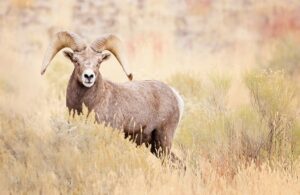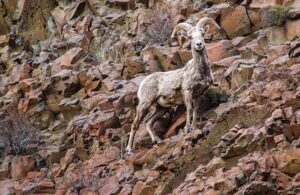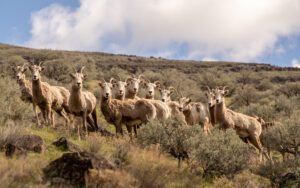Author: Renee Schiavone | Published: June 25, 2024 | Category: Species Spotlight
This article originally appeared in The Source Weekly on June 19, 2024.
Oregon’s high desert is home to fickle populations of stately California bighorn sheep.
Climbing to the top of 8,017 ft Warner Peak in the Hart Mountain National Antelope Refuge, my legs shake when I look over the edge. Cliffs and crags descend more than 3,000 feet to the valley floor from which I just climbed. From this perspective, I gain a new appreciation for the rugged habitat of one of North America’s most iconic species: California bighorn sheep. While the refuge I stand in is best known for its namesake population of pronghorn, its holds a long and complex history of bringing bighorns back to Oregon.

Bighorn sheep (Ovis canadensis) are a staple of the American West. Native to North America, they’re known for their impeccable climbing skills and massive curved horns. They’re stately creatures, most often found scaling rocky slopes and preferring rugged, open habitats with a good view of their surroundings. Bighorn sheep are a treat to witness, but getting the chance to see one in person is a rarity. This is due in large part to the history and subsequent scarcity of the species.
Oregon is home to two native subspecies of wild sheep: Rocky Mountain bighorn (Ovis canadensis ssp. canadensis) and California bighorn (O. c. californiana). Historically, California bighorns were the most abundant species in the state and found throughout southeastern Oregon’s high desert landscape, as well as in the watersheds of the Deschutes and John Day rivers. Bighorn’s habitat of choice — large, steep, rocky areas with good forage — affords them considerable protection, but they are preyed upon by cougars, wolves, bobcats, coyotes, bears and even golden eagles. Herds will migrate up and down in elevation as seasons, vegetation and water availability dictate.

Bighorns once ranged far and wide across the western part of the country. They inhabited a much larger variety of habitats than they do today and their populations were far greater. However, in the 1800s, nearly all populations were completely wiped out due to unregulated hunting, habitat loss from development and diseases contracted from domestic animals. By about 1912, the last California bighorn sheep was extirpated from Oregon.
Today, California bighorn sheep have returned to the state due to careful conservation efforts. Our current populations descend from sheep who were reintroduced via wildlife programs starting in the early 1950s. The initial effort translocated 20 sheep from British Columbia onto Oregon’s Hart Mountain National Antelope Refuge. The reintroduction was incredibly successful, and these Hart Mountain herds provided stock for other herds throughout southeastern Oregon. Over 600 bighorns relocated from Hart Mountain, producing more than 32 herds comprising of an estimated 3,700 sheep.

However, the evolution of bighorn sheep in Oregon does not quite end with this success story. California bighorns continue to be intensively studied and managed, but their highpoint was short lived. In the past two decades, the Hart Mountain herds have experienced a significant decline. Research has shown that long-term habitat degradation by invasive weeds and encroaching junipers, as well as climate change, are all contributing to Hart Mountain’s declining sheep population.
Oregon Natural Desert Association’s work to conserve the high desert’s biodiversity and most ecologically important landscapes includes some of the most storied and important bighorn sheep herds and habitats in the state. Protecting places like the Greater Hart-Sheldon, Owyhee Canyonlands and John Day River Basin improves the outlook for these icons of the West. Learn more about what you can do to protect these landscapes at www.onda.org.
—Renee Schiavone is the Communication Manager at Oregon Natural Desert Association, a nonprofit organization that protects and restores Oregon’s high desert public lands and waters. Read more of her work at onda.org/author/reneeschiavone.